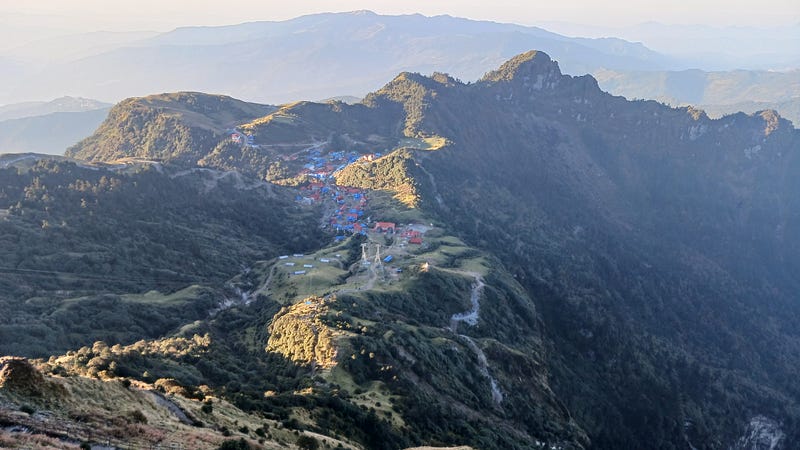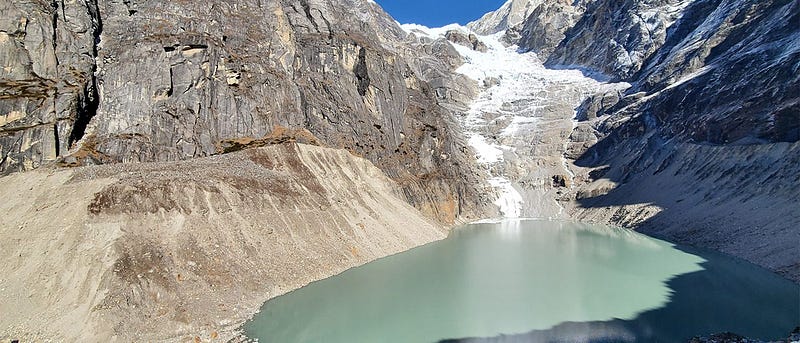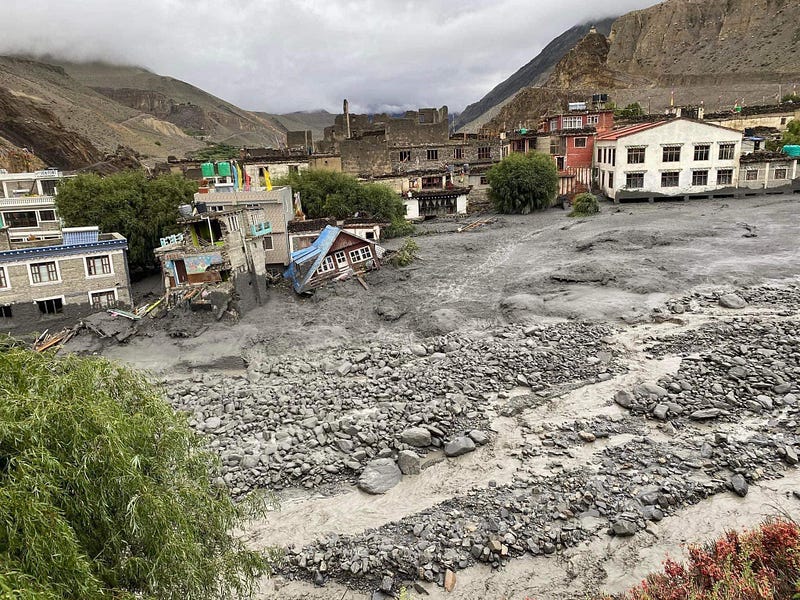Melting Glaciers in Nepal: A Village Buried by Flooding
Written on
On August 16, 2024, a rapid flood from the Thame River engulfed a significant part of a village in the Khumbu Pasang Lhamu Rural Municipality, located in Solukhumbu District, Nepal. Mingma Sherpa from Thamechho Kydug reported that the glacial structure containing Thengbo Lake near Tashi Lapcha Pass collapsed, releasing the lake's contents into the river almost instantaneously. This sudden influx surged downstream, inundating the village, also known as Thame.
Analysis revealed that another glacial lake discharged at the same time. In the higher elevations of the Khumbu region, five glacial lakes were identified, two of which failed, contributing to this flood event. Chief District Officer Devi Pandey Khatri of Solukhumbu cautioned that two of the remaining lakes seem precarious and still threaten the areas downstream.
The calamity that struck Thame was classified as a Glacial Lake Outburst Flood (GLOF). These floods occur when lakes situated in mountainous regions breach their barriers, releasing vast amounts of water into river systems that are not designed to handle such influxes. In this article, I will explore how climate change is responsible for the formation of glacial lakes, the basic structure of the two main types, and the reasons for their explosive discharges.
Before delving into the details, I, as a part-time resident of Nepal committed to disaster mitigation, wanted to learn about the situation of the villagers in Thame.
To gather information, I contacted my friend Kami Rita Sherpa, a local and the current world record holder for the most ascents of Mount Everest. Here is what he shared:
> "The disaster occurred during daylight, so fortunately no one was harmed. Had it taken place at night, the outcome could have been disastrous. I urge the climbing community and others to consider aiding the residents of Thame. We need support to recover and rebuild."
Kami Rita also directed me to a GoFundMe page established to assist his hometown, which has raised nearly $19,000 USD as of this writing.
A Global Concern: Melting Mountain Ice
In recent years, awareness of the alarming retreat of glaciers has grown globally. Public focus often centers on the vast ice sheets of the polar regions, which is understandable due to their size and visual impact. However, equally critical are mountain glaciers, which are melting at rates that may surpass those of polar ice.
Snowpack and glaciers at high altitudes are vital for over three billion people worldwide. Historically, predictable cycles of melting and freezing supported agriculture and industrial activities, leading to stable weather patterns and river flows. These conditions allowed for the generation of hydropower, a cleaner energy source compared to fossil fuels. Unfortunately, these patterns are now disrupted, leading to potential crises.
The consequences of these changes are evident; every mountain range is experiencing significant alterations, including accelerated glacial melting. In many regions, the current rate of melting is unprecedented compared to any observed in the last millennium, with some smaller glacial areas facing near-total disappearance within mere decades.
Ricky Lanusse recently highlighted the situation in the Andes Mountains:
> "A study from May 2024 indicates that the central range of Peru, close to Lima, could lose 84 to 98% of its glaciers by 2050, with total disappearance expected by 2056. This alarming forecast is compounded by the fact that Peru, which holds 68% of the world’s tropical glaciers, has already lost over half of them in the past 60 years, according to a government report from October 2023."
Alpine glaciers are not faring any better. Previous research I cited noted:
> "AI modeling combined with satellite data indicates an estimated 34% reduction in ice volume and approximately 32% reduction in area so far. At worst, alpine glaciers could see a decline of over 65% by 2050."
In Africa, the IPCC predicts the complete loss of glaciers on the Rwenzori Mountains and Mount Kenya by 2030, with similar outcomes expected for other smaller glacial masses worldwide over the next fifty years, including those in the European Alps, Pyrenees, Caucasus, North Asia, Scandinavia, tropical Andes, Mexico, eastern Africa, and Indonesia.

The Importance of Himalayan Ice
The melting of Himalayan ice presents a more pressing issue than that of any other mountain range globally. The challenges mirror those already discussed, but the scale of impact on human populations is far greater. The Himalayan mountains are crucial for feeding some of the world's most significant rivers, including the Indus, Ganges, Brahmaputra, Yangtze, Yellow, Mekong, Salween, and Tarim. Up to two billion people depend on these rivers for drinking water and agricultural activities, with many regions relying on mountain runoff for up to 75% of their irrigation.
Rising temperatures have dramatically altered climatic conditions in the Himalayas. Snowfall rates and the areas where snow accumulates have both declined across most of the region in recent decades, with the Karakoram area being a slight exception. Snowpack plays a crucial role in reflecting around 90% of incoming solar radiation, acting as insulation against warming. As snowpack diminishes, more glacial ice and surface rock are exposed, which in turn accelerates glacial melt.
Research on the South Col Glacier, the highest in the world, has shown that years of mass accumulation are now being lost annually. The researchers noted that smaller snowpacks at higher elevations mean that lower snowfall rates can increase glacial ablation by a factor of twenty, with changing wind patterns and atmospheric humidity worsening this degradation.
The situation observed at the South Col Glacier exemplifies a broader trend across the Himalayas. A group of researchers reconstructed data on 4,798 Himalayan glaciers from the Little Ice Age to the present, concluding:
> "The ten-fold increase in ice loss we have documented in the Himalayas significantly surpasses any centennial-scale changes recorded elsewhere on the planet."
Glacial melt is the primary cause of glacial lake formation. As these lakes proliferate, the risk of devastating GLOFs increases. In a prior article, I explored the implications of climate change in Nepal, discussing GLOFs:
> "The melting of glaciers leads to the creation or expansion of new glacial lakes, heightening the likelihood of GLOFs. Research by the International Centre for Integrated Mountain Development (ICIMOD) indicates that since 2003, four GLOF incidents have caused considerable damage or loss of life. ICIMOD has identified 47 glacial lakes currently posing a significant risk to lower-lying communities based on their size, location, and geological damming. The rapid melting of glaciers will undoubtedly exacerbate this hazard for vulnerable populations in the coming years."
The swift melting of glaciers in the Himalayas directly contributes to an increase in the number and size of glacial lakes. Climate change and human activities further amplify the likelihood of GLOF events, leading to substantial property damage, injuries, or fatalities. Urbanization in vulnerable areas destabilizes natural protections against flooding.
Understanding Glacial Lakes
Glacial lakes arise when glaciers retreat from glacial till—rocky debris formed from repeated glacial advances and retreats over millennia. Meltwater collects in low-lying areas either between the till and the glacier's ice front or in depressions carved by glacial erosion.
The latter are known as moraine-dammed glacial lakes. If the water retention relies on the glacier's ice front, they are termed ice-dammed glacial lakes. Both types can be hazardous, albeit for different reasons.

Moraine-dammed lakes can lead to GLOFs when water breaches the surrounding earthen or stone barriers. This typically happens when a significant mass is added to the lake, such as rockslides or calving glaciers. Less common triggers include heavy rainfall or rapidly melting snow and ice, which can create excessive water volume, as well as earthquakes that compromise the moraine's structure.
Ice-dammed lakes can also cause GLOFs due to excessive volume, which may occur suddenly or accumulate over time. As the water level rises sufficiently, it can lift the ice dam, allowing for a rapid outflow of lake water. After a significant volume of water escapes, the remaining water may no longer support the weight of the ice dam, causing it to settle back down and cease further outflow. Higher temperatures diminish the mass of ice dams, increasing their vulnerability to floating while simultaneously adding to the lakes' liquid volume.
In both scenarios, the downstream consequences can be severe, as a massive volume of water is suddenly introduced into existing riverbeds. At high elevations, these riverbeds are often narrow and bordered by steep terrain, forcing the water to flow downstream. Additionally, like a landslide, the rushing water can carry substantial amounts of debris.
Moraine GLOFs tend to be more dangerous in the short term due to higher discharge volumes compared to ice-dammed GLOFs. However, upon an outburst, the dam typically collapses, preventing the lake from reforming. Ice-dammed GLOFs release smaller volumes of water but can lead to repeated flooding from the same lake since they can "reseal" after discharge. In both situations, the water often brings along debris like mud, boulders, or sediment.
GLOF Threats in the Himalayas
The GLOF dashboard by the International Centre for Integrated Mountain Development (ICIMOD) provides historical and current data on incidents, recording 703 events resulting in 7,008 fatalities over nearly two centuries. Notably, 23% of these events involved the same lake multiple times. Avalanches, rockfalls, and landslides accounted for 54% of incidents, while heavy rainfall was responsible for 18%. ICIMOD identifies the Karakoram range of the Himalayas as the area with the highest GLOF risk.
Since 1980, the frequency of GLOF events has risen, particularly in Southeastern Tibet and along the China-Nepal border since 2010. One study estimates that approximately 6,353 square kilometers of land are currently at risk of GLOF exposure, impacting 55,808 buildings, 105 hydropower projects, 194 square kilometers of farmland, 5,005 kilometers of roads, and 4,038 bridges.
A case study of the 2016 GLOF on the Bhote Koshi River in Nepal illustrated the extent of the damage:
> "Twenty concrete houses, a boarding school, and parts of a customs office were swept away, with many other buildings damaged. Extensive road damage occurred, including a major highway linking Nepal to China; a hydropower facility was severely affected. Although rapid evacuations prevented fatalities, the economic impact was estimated at around $70 million."
Nepal experienced twenty-six GLOF events between 1977 and 2020, with nearly half originating from outside its borders. This statistic highlights the challenges in monitoring and managing GLOFs, as rivers fed by the Himalayas span multiple countries. One study found that one in six glacial lakes posed risks to at least two nations, predicting a threefold increase in danger in the coming decades. An additional study indicated that at least 15 million people worldwide reside in extremely high-risk regions.

Strategies for Mitigating GLOFs
Sadly, there are few solutions available to alleviate the societal and economic impacts of GLOFs. Many regions at highest risk lack the resources necessary for large-scale mitigation projects. Moreover, effective measures here primarily involve damage reduction, as no methods currently exist to prevent GLOFs altogether. Nonetheless, various community-based initiatives are in progress.
In Bhutan, government and private entities have launched educational campaigns to inform citizens about GLOFs and their potential triggers. Similar efforts are underway in Nepal, where my organization, the EALS Global Foundation, collaborates with Volunteer Corps Nepal (VCN) to disseminate information regarding GLOFs to villagers situated along rivers prone to these hazards.
Implementing early warning systems presents another avenue for reducing GLOF-related fatalities. In several regions of the Hindu Kush Himalaya, ICIMOD has introduced community-based flood early warning systems (CBFEW), which enlist volunteers to monitor conditions for flood potential. When specific thresholds are met, these volunteers alert downstream communities, providing them with crucial time to evacuate and secure livestock and essential belongings. EALS Global is enhancing this system using advanced technology to reach more isolated areas.
While these measures are not foolproof, they represent steps toward addressing the risks. Unfortunately, until the global community takes climate change more seriously, GLOF events will not only continue but are likely to increase in frequency.
If you are interested in the section about the sherpas, consider reading my companion piece, **Chronicling the Lives of Sherpas*.*
Robert Vanwey serves as the co-director of the **Dharma Farm School of Translation and Philosophy* and is the executive director of the EALS Global Foundation.*
To follow Rob's work, consider subscribing to the **Evidence Files Substack*, where he explores topics in technology, science, aviation, and the Himalayas, where he frequently resides and works.*